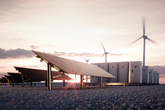Rystad Energy: Renewable energy capacity set to soar in Asia-Pacific
Published by Sarah Smith,
Assistant Editor
Energy Global,
Installed capacity of renewable energy in the Asia-Pacific region is set for a major boost in the next five years, to 815 GW in 2025 from 517 GW this year, a Rystad Energy analysis shows. The frontrunner in this growth will be solar energy, whose regional capacity will nearly double to 382 GW from 215 GW in 2020, surpassing even the installed capacity of well-established onshore wind energy.

Onshore wind’s installed capacity is also set to climb, to 341 GW from 266 GW in the next five years, while offshore wind is expected to jump to 51 GW from 9 GW currently. Lastly, storage, battery and hydrogen electrolyser capacity is likely to expand to 42 GW from 26 GW, Rystad Energy states.
“Renewable energy growth has led engineering, procurement, construction and installation (EPCI) service providers in the region and Asian fabrication yards to fast-track their energy transition plans to actively target low-carbon markets and tender for such contracts,“ stated Lin Lin Goh, Senior Energy Service Research Analyst at Rystad Energy.
Many national oil companies (NOCs) in the Asia-Pacific region are now following in the footsteps of their European counterparts and are starting their journey towards energy transition. In Malaysia, Petronas has announced that it will grow its presence within renewables and recently invested in a solar photovoltaic system for the residential and small- to medium-sized enterprises sectors in Malaysia, Rystand Energy reports.
China’s three biggest NOCs – Petrochina, Sinopec and CNOOC – are also looking to diversify into wind and hydrogen power. In Vietnam, PetroVietnam has announced an ambitious target of 100 MW renewable capacity by 2025 and 900 MW by 2035, which would make the country the most promising market for offshore wind in Southeast Asia, states Rystand Energy.
Some significant offshore wind projects on the cards in the Asia-Pacific region, excluding China, are Yunlin, Changfang and Xidao in Taiwan, Thang Long in Vietnam and Incheon in South Korea.
Following the demand from their customer base, many traditional oilfield service companies in the region have also started diversifying their offerings to cater to the energy transition. The most relevant sector for the EPCI companies to venture into within green energy is offshore wind construction and installation. Both oilfield and wind projects offshore have long project life cycles that require integrated project management on a massive scale, dealing with mammoth structures such as jackets, platforms and foundations.
EPCI companies, with a proven track record in oilfield services, have an edge when it comes to applying best practices and can leverage existing personnel competencies in every stage of an offshore wind construction and installation project, from design to operations. Floating offshore wind may also be an avenue for EPCI companies to capitalise on their experience in deepwater production facility installations and will be important in countries such as Japan and South Korea.
Asian fabrication yards will also benefit from the surge in offshore wind projects globally. Although most Chinese fabrication yards serve domestic demand for wind power, due to cost competitiveness some are also on the hunt for market share in the international renewables market.
For more news and technical articles from the global renewable industry read our latest issue of Energy Global magazine.
Energy Global’s Summer 2020 issue
The Summer issue of Energy Global provides in-depth technical articles covering technological advancements and future outlooks in the renewables sector, from companies including Sulzer, Power Ledger, JinkoSolar, Trelleborg Applied Technologies, Clir Renewables, and many more. The issue covers a spectrum of clean energies, from wind to hydrogen to solar to biofuels.
Read the article online at: https://www.energyglobal.com/special-reports/21102020/rystad-energy-renewable-energy-capacity-set-to-soar-in-asia-pacific/
You might also like
Infinigen Renewables announces solar+battery storage project in Puerto Rico
Infinigen Renewables and ArcLight Capital Partners have announced a 15 MW storage project paired with a 32 MW solar project in the Yabucoa Municipality of Puerto Rico.

